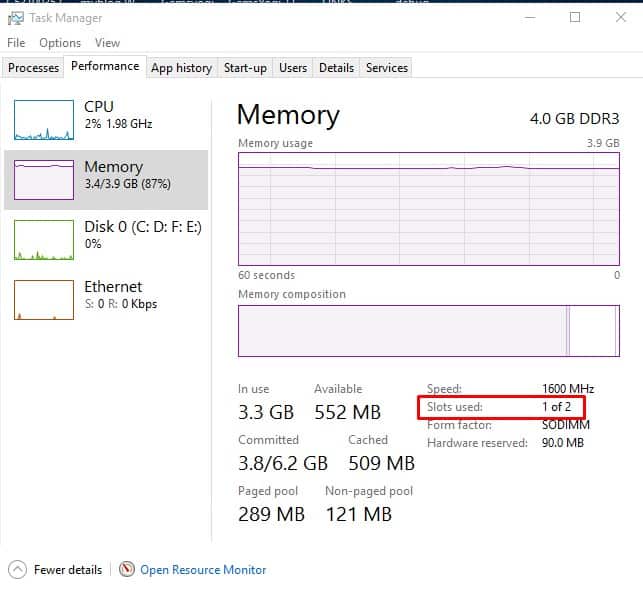Linux Check Memory Slots Used
Posted : admin On 12/30/2019- Nov 14, 2019 I added 'Total memory populated' (The sum of all non-empty slots), & 'NO EMPTY SLOTS - ALL SLOTS POPULATED' (if no free slots); & '# of slots available/open.' So, here I have part of my suggested enhancement - could not figure how to enumerute specific empty slots, so I left 2 lines commented out, if someone knows.
- @azorius (and probably unimplemented) means the bios/chipset can handle 4 slots, but the board manufacturer decided not to include 2 of the possible slots the bios can support in the physical realm that is the actual MB.
When a user wants to add or upgrade memory (RAM) in a computer, they need to know how many memory slots are available. The following section will help you to determine the number of memory slots in your computer, as well as how many are currently being used.
You also have the option to opt-out of these cookies. These cookies will be stored in your browser only with your consent.  We also use third-party cookies that help us analyze and understand how you use this website.
We also use third-party cookies that help us analyze and understand how you use this website.
Windows Task Manager
The easiest solution for Windows users is to open the Windows Task Manager.
May 21, 2018 Check ESXI host ram/slots used pstoric Jul 17, 2012 8:23 AM I found it once before in vsphere I think where I could see how much ram was installed and what slot it was installed in but I cannot seem to find it again. Feb 21, 2018 The ability to check memory usage on Linux systems follows the popular UNIX philosophy “there’s more than one way to do it”. We have multiple commands to check and diagnose memory usage on Linux systems. The free command displays the total amount of free and used physical and swap memory in the system, as well as the buffers used by the kernel. Aug 19, 2015 du -hs, which stands for disk usage, checks for the space used on our device in a human friendly format. This command is less useful, but sometimes, instead of needing to look at the summary of memory on the hard drive, we only require looking at the disk space we have already used. How to Check RAM Slots in Linux. If the issue is with your Computer or a Laptop you should try using Reimage Plus which can scan the repositories and replace corrupt and missing files. This works in most cases, where the issue is originated due to a system corruption. You can download Reimage by clicking the Download button below. Download Now. The number of memory devices in the results of sudo dmidecode -type 17 is equal to the number of memory slots, so the command to print the number of RAM slots is. Sudo dmidecode -type 17 grep 'Memory Device' -count The results of this command will be one integer number equal to the number of RAM slots.
- Press the Windows key, type Task Manager, and then press Enter.
- In the window that appears, click the Performance tab (A), then select Memory (B).
- In the lower-right corner, the number of slots is displayed in the Slots used: section (C).
- As you can see, this computer has a total of four memory slots, although only two are currently being utilized.
Use the CPU-Z utility
Another way to get information about memory slots and details about the RAM currently installed on your computer, is to use the free CPU-Z third-party utility.
- Open an Internet browser and visit the CPUID website.
- On the left side of the screen, select your operating system.
- On the next page, select your preferred language.

- On the next screen, click the DOWNLOAD NOW! button.
- Once the download has finished, install it from your browser and open the program.
- Click the SPD tab at the top of the screen, and then click the down arrow in the Memory Slot Selection section.
- As you can see in the image above, all of the memory slots (in this case, four) are listed in the drop-down menu.
If you select a different slot from the drop-down menu, CPU-Z will tell you additional information about the RAM that is installed, or nothing if the slot is unoccupied.
Examine the motherboard
Sometimes the best way to determine the available memory slots is to open the computer and examine the motherboard. Opening the computer is the best option if were unable to get the Windows Task Manager or CPU-Z to work.
Looking inside the case, the motherboard is the primary large circuit board. On most motherboards, the memory slots are located on either side of the CPU, and resemble what is shown below.
Most computer motherboards have two, three, or four memory slots. Bao moi tay ninh casino phuoc chi. Some higher-end motherboards have as many as eight. The motherboard in the picture above has no memory modules installed in any of its three slots.
Linux Memory Check
NoteIf your computer has no memory slots available and you want to upgrade, you must remove and replace some of the existing memory.
Additional information
Linux Check Memory Info
- See our memory definition for further information and related links.